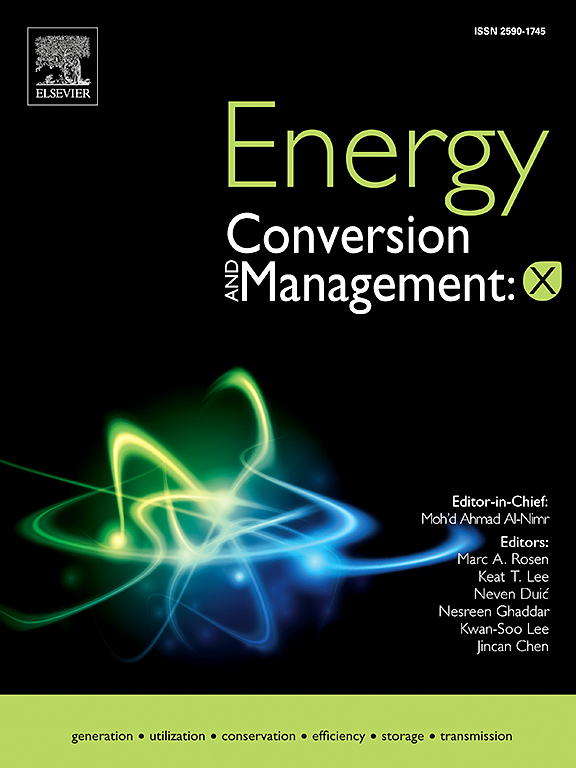Innovative methodology for optimized design and thermo-economic analysis of pillow-plate latent heat thermal energy storage: a case study on heat recovery in the brewing industry
IF 9.9
1区 工程技术
Q1 ENERGY & FUELS
引用次数: 0
Abstract
This paper investigates the novel class of pillow-plate latent heat thermal energy storage (PP-LHTES) systems based on the combined use of phase change materials (PCM) of pillow plate heat exchanger technology. Despite recent studies highlighting the promising thermal and economic performance of PP-LHTES systems, their investigation remains limited. In particular, there is a lack of comprehensive thermo-economic analyses to support informed decision-making, especially during the design phase. To address this gap, this paper systematically explores the thermo-fluid and economic performance of PP-LHTES systems by analyzing their design space. An innovative procedure for the optimal design of these devices was developed. The proposed methodology consists of two models: a 1D analytical discretized stationary model, called the design model, and a 1D analytical discretized dynamic model, named the dynamic model. The former is used to determine the design parameters and costs, while the latter is used to validate the designed system under dynamic conditions. The two models are validated against relevant experimental studies taken from the literature and show good performances with errors in the order of 10 % for the design model and 2 % for the dynamic model. A total of 27 configurations were evaluated for potential industrial applications, considering energy storage capacities between 5 and 25 MWh and heat transfer rates ranging from 1 to 5 MW. Representative case studies and operating maps highlight the effects of inlet and outlet temperatures and PCM properties on performance. The layer thickness of the storage material and the channel length depend on discharge time, while the channel count remains constant at a fixed heat transfer rate. The heat exchange area, however, varies with energy storage capacity and heat transfer rate. Additionally, cost maps are systematically examined in terms of energy capacity cost ($/kWh) and power capacity cost ($/kW), highlighting the critical relationship between key PP-LHTES design parameters and the overall cost-competitiveness of the technology. Systems designed for higher temperature differentials (ΔT) demonstrated superior thermal and economic performance, reducing the required heat exchange area and lowering both energy and power capacity costs. An exemplar case study is developed, starting from a reference case in the literature, to illustrate the effectiveness of the proposed methodology. This case study outlines the process of gathering input parameters and demonstrates how the outputs of the two models should be processed to achieve the final design. Ultimately, PP-LHTES emerges as a promising and viable solution for industrial applications at the medium and large scales, with energy capacity costs ranging from 30 to $90 per kWh.
枕板式潜热蓄热优化设计及热经济分析的创新方法——以酿酒工业热回收为例
本文研究了基于相变材料与枕板式换热器技术相结合的新型枕板式潜热蓄热系统。尽管最近的研究强调了PP-LHTES系统有前景的热学和经济性能,但它们的研究仍然有限。特别是,缺乏全面的热经济分析来支持明智的决策,特别是在设计阶段。为了解决这一差距,本文通过分析PP-LHTES系统的设计空间,系统地探讨了其热流体和经济性能。提出了一种创新的装置优化设计方法。提出的方法包括两个模型:一维解析离散平稳模型(称为设计模型)和一维解析离散动态模型(称为动态模型)。前者用于确定设计参数和成本,后者用于在动态条件下验证所设计的系统。通过文献中相关实验研究的验证,两种模型均表现出良好的性能,设计模型误差在10%左右,动态模型误差在2%左右。考虑到储能容量在5到25兆瓦时之间,传热速率在1到5兆瓦之间,总共评估了27种配置,用于潜在的工业应用。代表性案例研究和操作图突出了进出口温度和PCM特性对性能的影响。存储材料的层厚和通道长度取决于放电时间,而通道数在固定的传热速率下保持不变。然而,换热面积随能量储存容量和换热速率而变化。此外,根据能源容量成本($/kWh)和电力容量成本($/kW),系统地检查了成本图,突出了PP-LHTES关键设计参数与技术整体成本竞争力之间的关键关系。专为更高温差设计的系统(ΔT)表现出卓越的热学和经济性能,减少了所需的热交换面积,降低了能源和电力容量成本。从文献中的参考案例开始,开发了一个范例案例研究,以说明所提出方法的有效性。本案例研究概述了收集输入参数的过程,并演示了如何处理两个模型的输出以实现最终设计。最终,PP-LHTES将成为一种有前途的、可行的解决方案,适用于大中型工业应用,其能源容量成本在每千瓦时30至90美元之间。
本文章由计算机程序翻译,如有差异,请以英文原文为准。
求助全文
约1分钟内获得全文
求助全文
来源期刊

Energy Conversion and Management
工程技术-力学
CiteScore
19.00
自引率
11.50%
发文量
1304
审稿时长
17 days
期刊介绍:
The journal Energy Conversion and Management provides a forum for publishing original contributions and comprehensive technical review articles of interdisciplinary and original research on all important energy topics.
The topics considered include energy generation, utilization, conversion, storage, transmission, conservation, management and sustainability. These topics typically involve various types of energy such as mechanical, thermal, nuclear, chemical, electromagnetic, magnetic and electric. These energy types cover all known energy resources, including renewable resources (e.g., solar, bio, hydro, wind, geothermal and ocean energy), fossil fuels and nuclear resources.
 求助内容:
求助内容: 应助结果提醒方式:
应助结果提醒方式:


